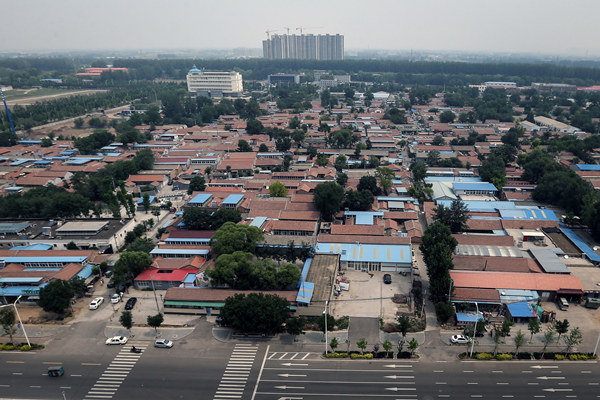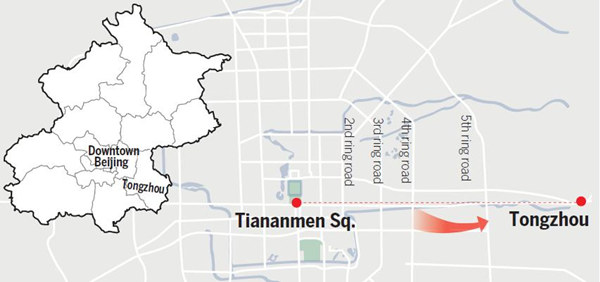
Demolition starts in Lucheng, Tongzhou district, proposed site of the subsidiary administrative center, in June. [Photo by Hei Ke/China Daily]
Beijing plans to transfer industries and activities that are not related to its role as the nation's capital to its suburbs and neighboring Hebei province and Tianjin, the municipal legislative body has announced.
In addition, extensive measures will be taken to cap population growth in downtown areas.
There will be a greater focus on Tongzhou district in the southeast as it emerges as the city's "subsidiary administrative center", and construction work there is expected to make "remarkable progress" by 2017.
The announcement was made on Saturday at the conclusion of a plenary session of the city's Party committee at which the municipal leadership approved a road map to promote the regional integration of Beijing, Tianjin and Hebei.
The municipal government has seen that there is increasing concern about the conflict between a growing population and restricted natural resources, and urban problems such as traffic congestion, Guo Jinlong, Beijing's Party chief, said at the session.
These issues are rooted in the rapid economic development of the city, an incomplete understanding of the problems and the absence of strong measures to tackle them, he said.
Beijing will make comprehensive efforts to push forward regional integration, "which is a challenging test, but also the fundamental way out of the current thorny problems", Guo said.
The integration road map says the city should stick to its population control target of 23 million by 2020, and the number of people living within the six downtown areas should be cut by 15 percent by then.
The city's total population stood at 21.5 million in 2014, according to the municipal government.
A top priority of the road map is to move out industries that are not related to Beijing's "capital functions"?its role as the capital and the national center of politics, culture, international exchanges and technical innovation.
The city has released a list of industries whose development will be restricted. For example, hospitals in the downtown districts of Dongcheng and Xicheng will not be allowed to add beds, according to a report broadcast by China Central Television on Saturday.
The 1,200 companies in the capital involved in industries that cause pollution will be relocated by 2017, Guo said.
The transfer of industries away from Beijing is benefiting Hebei. For example, Cangzhou in the province has built an industrial zone to accommodate stone processing companies that have moved out. The initiative has attracted more than 110 companies with a combined annual output worth more than 4.9 billion yuan ($789 million).
Further research will be conducted into plans to transform Tongzhou into a subsidiary administrative center.
Yu Zhongfu, an expert from the research office of the capital's Party committee, said detailed studies should be carried out before the capital relocates administrative bodies, and decisions should be made with a long-term perspective.
Though Beijing faces "urban diseases" such as congestion, there is still time for the capital to conduct thorough research to determine which departments should move to Tongzhou and how much influence the subsidiary center should have, Yu added.
He said the government should invite the public to participate in the decision-making process and ensure that the policies go through legal processes.

??Beijing's growth plan
21.5 million lived in Beijing in 2014, according to the municipal government.
23 million Capital's 2020 population control target
15 percent targeted reduction in residents in Beijing's six downtown areas by 2020
Contact the writers at zhengjinran@chinadaily.com.cn.